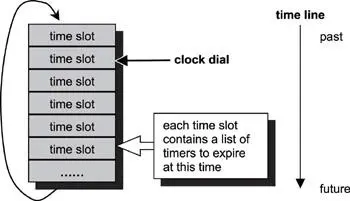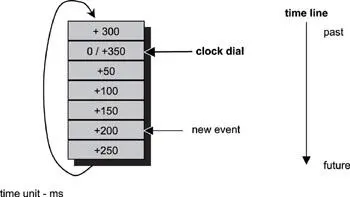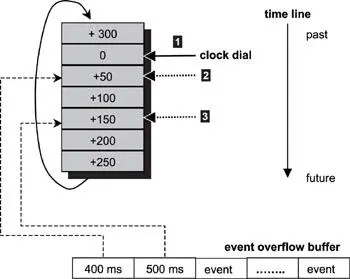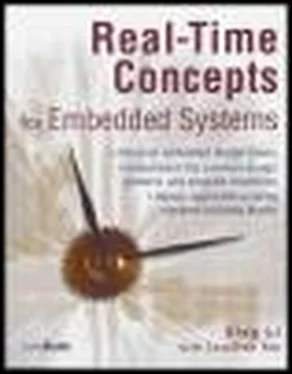
Figure 11.7: Level 2 delays-priority-based, task-scheduling delays.
Another delay is introduced when an application installs many soft timers. This issue is explored further in the next section when discussing the concept of timing wheels.
11.5.2 Implementation Considerations
A soft-timer facility should allow for efficient timer insertion, timer deletion and cancellation, and timer update. These requirements, however, can conflict with each other in practice. For example, imagine the linked list-timer implementation shown in Figure 11.8. The fastest way to start a timer is to insert it either at the head of the timer list or at the tail of the timer list if the timer entry data structure contains a double-linked list.

Figure 11.8: Maintaining soft timers.
Because the timer list is not sorted in any particular order, maintaining timer ticks can prove costly. Updating the timer list at each tick requires the worker task to traverse the entire linked list and update each timer entry. When the counter reaches zero, the callout function is invoked. A timer handle is returned to the application in a successful timer installation. The cancellation of a timer also requires the worker task to traverse the entire list. Each timer entry is compared to the timer handle, and, when a match is found, that particular timer entry is removed from the timer list.
As shown in Figure 11.9, while timer installation can be performed in constant time, timer cancellation and timer update might require O( N ) in the worst case.

Figure 11.9: Unsorted soft timers.
Sorting expiration times in ascending order results in efficient timer bookkeeping. In the example, only the first timer-entry update is necessary, because all the other timers are decremented implicitly. In other words, when inserting new timers, the timeout value is modified according to the first entry before inserting the timer into the list.
As shown in Figure 11.10, while timer bookkeeping is performed in constant time, timer installation requires search and insertion. The cost is O(log(N)), where N is the number of entries in the timer list. The cost of timer cancellation is also O(log(N)).

Figure 11.10: Sorted soft timers.
As shown in Figure 11.11, the timing wheel is a construct with a fixed-size array in which each slot represents a unit of time with respect to the precision of the soft-timer facility. The timing wheel approach has the advantage of the sorted timer list for updating the timers efficiently, and it also provides efficient operations for timer installation and cancellation.

Figure 11.11: Timing wheel.
The soft-timer facility installs a periodic timeout (a clock tick) using the underlying timer hardware. This hardware-based periodic timer, drives all of the soft timers installed within the facility. The frequency of the timeout determines the precision of the soft-timer facility. For example, if the precision defines a tick occurrence every 50ms, each slot represents the passing of 50ms, which is the smallest timeout that can be installed into the timer facility. In addition, a doubly linked list of timeout event handlers (also named callback functions or callbacks for short) is stored within each slot, which is invoked upon timer expiration. This list of timers represents events with the same expiration time.
Each timer slot is represented in Figure 11.12.

Figure 11.12: Timeout event handlers.
The clock dial increments to the next time slot on each tick and wraps to the beginning of the time-slot array when it increments past the final array entry. The idea of the timing wheel is derived from this property. Therefore, when installing a new timer event, the current location of the clock dial is used as the reference point to determine the time slot in which the new event handler will be stored. Consider the following example as depicted in Figure 11.13. Assume each time slot represents the passing of 50ms, which means that 50ms has elapsed between ticks.

Figure 11.13: Installing a timeout event.
The time slot marked +200 is the slot in which to store an event handler if the developer wants to schedule a 200ms timeout in the future. The location of the clock dial is the 'beginning of time' on the time line, in other words, the reference point. At a minimum, the timer handle returned to the calling application is the array index.
A number of issues are associated with the timing wheel approach. The number of slots in the timing wheel has a limit, whatever that might be for the system. The example in Figure 11.13 makes this problem obvious. The maximum schedulable event is 350ms. How can a 400ms timer be scheduled? This issue causes an overflow condition in the timing wheel. One approach is to deny installation of timers outside the fixed range. A better solution is to accumulate the events causing the overflow condition in a temporary event buffer until the clock dial has turned enough so that these events become schedulable. This solution is illustrated in Figure 11.14.

Figure 11.14: Timing wheel overflow event buffer.
For example, in order to schedule a 400ms timeout when the clock dial is at location 1, this event must be saved in the event overflow buffer until the clock dial reaches location 2. To schedule a 500ms timer when clock dial is at location 1, this event must be saved in the event overflow buffer until the clock dial reaches location 3. The expired events at location 2 and location 3 must be serviced first, and then the new events installed. The event overflow buffer must be examined to see if new events need to be scheduled when the clock dial moves at each clock tick to the next slot. This process implies that the events in the overflow buffer must be sorted in increasing order. New events are inserted in order and can be expensive if the overflow buffer contains a large number of entries.
Another issue associated with the timing wheel approach is the precision of the installed timeouts. Consider the situation in which a 150ms timer event is being scheduled while the clock is ticking but before the tick announcement reaches the timing wheel. Should the timer event be added to the +150ms slot or placed in the +200ms slot? On average, the error is approximately half the size of the tick. In this example, the error is about 25ms.
One other important issue relates to the invocation time of the callbacks installed at each time slot. In theory, the callbacks should all be invoked at the same time at expiration, but in reality, this is impossible. The work performed by each callback is unknown; therefore, the execution length of each callback is unknown. Consequently, no guarantee or predictable measures exist concerning when a callback in a later position of the list can be called, even in a worst-case scenario. This issue introduces non-determinism into the system and is undesirable. Figure 11.15 illustrates the problem.
Читать дальше




















